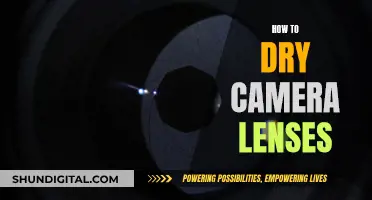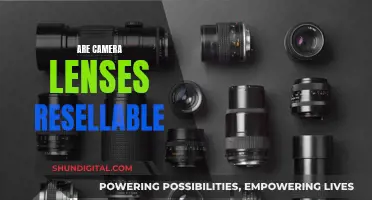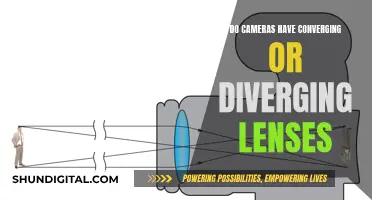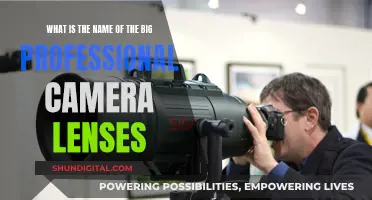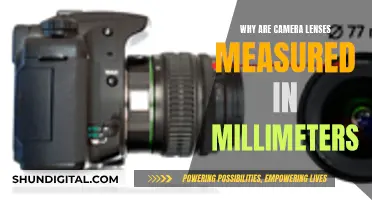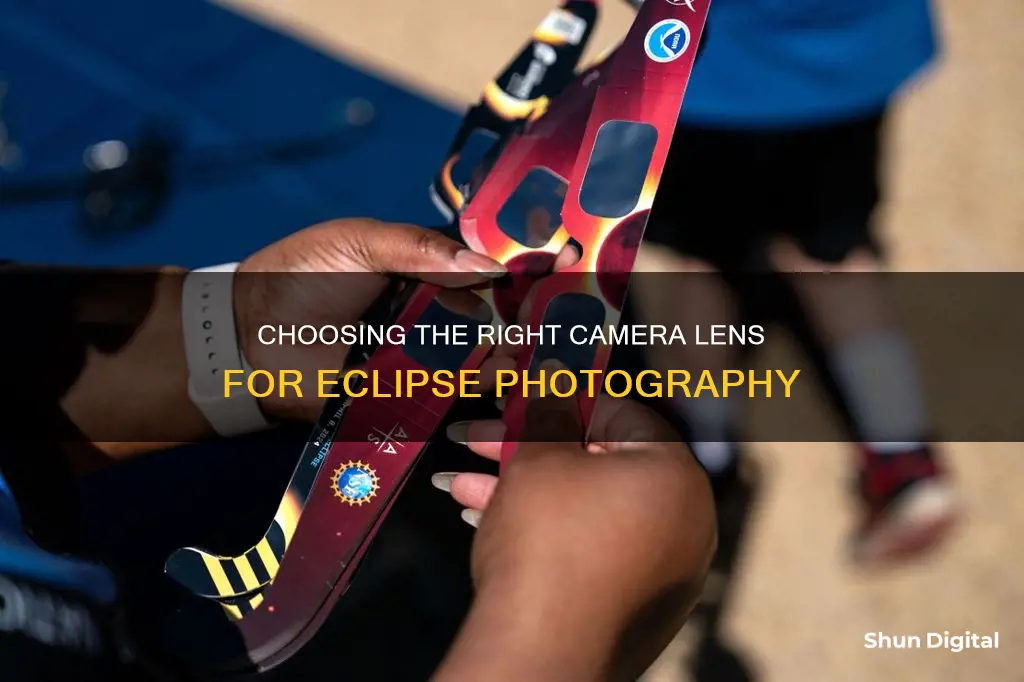
Capturing the perfect photo of an eclipse can be tricky, but with the right camera lens, it's possible. Here's a quick guide to help you choose the best lens for shooting an eclipse.
First, it's important to understand the different types of eclipses. There are partial eclipses, where the moon only blocks part of the sun, and total eclipses, where the moon fully covers the sun. For partial eclipses, you'll need a solar filter to protect your eyes and camera sensor. Total eclipses, on the other hand, can be viewed and photographed without a filter, but only during the brief period of totality.
When choosing a lens for shooting an eclipse, consider the focal length. A longer focal length will allow you to get a closer, more detailed shot of the eclipse. For a DSLR or mirrorless camera with a full-frame sensor, choose a focal length of 2000mm or less. For a camera with a DX sensor, the maximum focal length is about 1300mm. If you want to capture the sun's corona during totality, a shorter focal length is better – no more than 1400mm for a full-frame camera, or 900mm for a DX camera.
In addition to the focal length, you'll also need to consider the type of camera you're using. For a DSLR or mirrorless camera, you can combine a super telephoto lens with a teleconverter to increase the focal length. You can also use a camera with a built-in superzoom lens, or even a telescope adapted for photography. Just make sure to use a sturdy tripod to avoid camera shake.
Remember, it's crucial to prioritise eye safety when photographing an eclipse. Always use accredited and approved solar filters to protect your eyes and camera equipment. With the right lens and safety precautions, you'll be ready to capture stunning photos of the next eclipse.
What You'll Learn

Use a solar filter to protect your eyes and camera
Solar filters are essential when photographing an eclipse. The sun is so bright that unfiltered sunlight can permanently damage your eyes and your camera's optics.
Solar filters are made from specialized materials that effectively block harmful ultraviolet (UV) and infrared (IR) radiation while allowing a tiny amount (0.00001%) of visible light to pass through. They block or attenuate nearly all sunlight so you can safely observe solar phenomena such as sunspots, solar eclipses, and planetary transits.
There are three types of solar filters: metal on glass (usually the most durable and expensive), aluminized polyester film (frequently but incorrectly referred to as aluminized Mylar), and black polymer (sometimes with a metal coating on at least one side). Some render the sun white, while others impart a yellow, orange, or bluish tint. All are effective, so choose the type that best suits your preference and budget.
Solar filters must be attached to the front of your camera lens. This ensures that the sun's light and heat are kept out of the optics. Make sure the filter is attached securely so it won't pop off if your camera is bumped or the wind suddenly gusts. If you're using a camera with a telephoto lens in the path of totality, avoid using a solar filter that screws onto the front of the lens, as they can be challenging to remove and replace. Instead, use a solar filter sheet with a rubber band.
Repairing Moto X4 Camera Lenses: A Step-by-Step Guide
You may want to see also

Choose a lens with a long focal length to capture a large image of the sun
Capturing a large image of the sun during an eclipse requires a lens with a long focal length. A standard 18mm lens on a DSLR yields a minuscule image of the sun, while a 200mm telephoto or zoom lens produces an image four times larger. A 500mm focal length is a common choice, yielding a great image scale for photographing solar eclipses.
When choosing a lens for eclipse photography, it's important to consider the type of camera you're using. For a DSLR camera, a lens with a focal length of around 300mm or more will give you a good-sized sun in your frame. If you're using a cropped-sensor camera, a lens with a focal length of 450mm or more will provide a similar effect.
It's also worth noting that the sensor size of your DSLR will impact the apparent size of the sun in your images. Full-frame sensors, typically found in professional or upper-end DSLR cameras, will make the sun appear smaller compared to crop sensors found in less expensive consumer DSLRs.
Additionally, if you plan on including foreground objects or scenery in your eclipse photos, you may want to use a wide-angle lens. Keep in mind that the sun will appear smaller in your frame when using a wide-angle lens, but this can still result in fantastic images depending on the type of shot you're aiming for.
In summary, to capture a large image of the sun during an eclipse, choose a lens with a long focal length, ideally 500mm or more, and consider the type of camera and sensor you're using to ensure the sun appears the desired size in your frame.
Polarized Lenses vs UV Camera Filters: What's the Difference?
You may want to see also

Use a wide-angle lens to capture the foreground scenery
Capturing an eclipse is an exciting endeavour, and using a wide-angle lens can help you get a great shot. Here are some tips for using a wide-angle lens to capture the foreground scenery during an eclipse:
- Understand your equipment: Wide-angle lenses have a focal length of 35mm or shorter, giving you a broader field of view. This will help you capture more of the scene in your frame.
- Choose the right lens: Select a wide-angle lens that fits your desired scenery. Ultrawide-angle lenses have focal lengths under 16mm, while standard wide-angle lenses range from 24mm to 35mm.
- Get close to your subject: Wide-angle lenses excel when you get close to your subject. This will exaggerate the relative sizes of near and far objects, making nearby objects appear larger than those in the distance.
- Be mindful of distortion: Wide-angle lenses can cause barrel distortion, where straight lines appear curved. This is particularly important to watch out for when photographing people, as features like noses and heads can become disproportionately large.
- Manage light carefully: Wide-angle lenses are more susceptible to lens flare and variations in light intensity across the image. Consider using a graduated neutral density (GND) filter to manage uneven lighting and reduce the risk of lens flare.
- Experiment with composition: Wide-angle shots often include a lot of elements, so it's important to carefully organise your composition to avoid confusion. Try using foreground objects to guide the viewer's eye into the image or experiment with layering.
- Pay attention to perspective: When using a wide-angle lens, be mindful of converging verticals. Pointing your camera above or below the horizon will make parallel vertical lines appear to converge. If you want to avoid this effect, keep your camera pointed at the horizon.
- Practice makes perfect: The best way to master wide-angle photography is to practice. The more you shoot with your wide-angle lens, the better you'll become at visualising and capturing strong wide-angle compositions.
The Wide World Through Wide-Angle Lenses
You may want to see also

Use a tripod to stabilise your camera
Capturing an eclipse is a fun and easy activity. However, it is important to use a special solar filter to protect your eyes and your camera.
To get the perfect shot, you will need to stabilise your camera using a tripod. Here are some tips to help you get the most out of your tripod and ensure your camera is stable:
- Check the payload of your tripod head and legs to ensure they can support the weight of your camera equipment.
- Check the feet of your tripod for rubber spikes. These can be used on softer surfaces, like grass, to provide better grip than rubber feet.
- When extending the tripod legs, start with the thickest, uppermost sections first. Then, move on to the second-thickest section, and so on.
- Only extend the centre column of your tripod after you have fully extended all the leg sections. Extending the centre column will compromise stability.
- Avoid overtightening the screw locks on your tripod. Doing so can cause damage to your equipment.
- Utilise the hook on the underside of the centre column to hang a bag or weight and add extra stability to your tripod, especially in windy conditions.
- If you are using a telephoto lens, mount it using the collar to redistribute and balance the weight of the camera and lens.
- When adjusting the height of your tripod, always extend the bottom legs first to prevent dirt, sand, and grit from getting inside the next leg.
- Extend the tripod legs fully to stabilise your camera further and get lower shots if needed.
- Ensure your tripod is level by using the spirit level on the tripod head or visually checking that the centre column is vertical.
- Position one tripod leg at the same angle as your camera lens to reduce the chance of the tripod falling forward.
- Only use the centre column to gain extra height if absolutely necessary, as it destabilises the weight distribution.
- Use a cable release, wireless remote, or self-timer to trigger the exposure and avoid introducing movement and vibration to your setup.
- Turn off image stabilisation on your camera or lens when using a tripod, as it may detect vibrations and attempt to correct them, creating a loop of vibration and correction that can affect the sharpness of your images.
By following these tips, you can effectively use a tripod to stabilise your camera and capture stunning images of the eclipse.
Camera Lenses: Heavy Weights for the Perfect Shot
You may want to see also

Remove the solar filter during totality to capture the sun's corona
Capturing the sun's corona during a solar eclipse is a tricky task, but with the right equipment and preparation, it can be done. Here are some tips to help you capture this awe-inspiring phenomenon:
Remove the Solar Filter During Totality
During a total solar eclipse, the moon passes between the Earth and the Sun, blocking out the bright light of the Sun. This brief period of totality is the only time when it is safe to view the Sun with the naked eye and also the best opportunity to capture the Sun's corona. It is crucial to remove any solar filters from your camera lens during totality, as these filters are too dark to allow the corona to be photographed. The corona is much dimmer than the Sun itself, so photographing it requires a different approach.
Choose the Right Lens
To capture the Sun's corona in all its glory, you'll need a telephoto lens. A telephoto lens will allow you to zoom in on the Sun and capture a close-up of the corona. The more focal length you can get, the better. Canon's 70-200mm F2.8 lens is a popular choice for its exceptional image quality, but other options like Canon's 75-300mm or Nikon's AF-S DX 55-300mm f/4.5-5.6G ED VR lens can also get the job done. If you're looking for a more affordable option, Tamron offers telephoto lenses that are compatible with both Canon and Nikon cameras. Keep in mind that as the focal length increases, the size and weight of the lens also increase, so consider the weight your camera equipment before making a decision.
Use a Tripod
A sturdy tripod is essential for capturing sharp images of the Sun's corona. Even the slightest movement of the camera can result in blurry photos when using a long focal length lens. Look for a tripod that is specifically designed to support heavy telephoto lenses, such as the Manfrotto MKCOMPACTADV-BK or the Manfrotto MKBFRA4-BH.
Use a Remote Shutter Release
To avoid any camera shake that could ruin your shot, it's best to use a remote shutter release. This will allow you to trigger the shutter without touching the camera, ensuring that your long-exposure shots remain sharp and clear. You can use either a wired or wireless remote shutter release, whichever you find more convenient.
Consider an Equatorial Tracker
The Sun moves quickly across the sky, and during a solar eclipse, every moment is precious. An equatorial tracker is a device that automatically pans your camera to follow the Sun's path, allowing you to capture hands-free shots. While this piece of equipment is not essential, it can be a worthwhile investment if you're serious about eclipse photography.
Practice and Prepare
Before the big day, be sure to practice setting up your equipment and familiarise yourself with the techniques mentioned above. Check the weather forecast and scout out a location that offers a clear view of the sky and, if possible, an interesting foreground to include in your shots. Make sure you have all the necessary equipment, including spare batteries and memory cards, and don't forget to bring your solar eclipse glasses to protect your eyes during the partial eclipse phases.
Remember, the key to capturing the Sun's corona during a solar eclipse is to be prepared, stay flexible, and most importantly, enjoy the experience. Solar eclipses are rare and breathtaking events, so take the time to appreciate the moment while you capture your photographs.
Active Camera Differences: S7 Active vs Regular S7
You may want to see also
Frequently asked questions
You can shoot an eclipse with any type of camera lens, but a super telephoto lens will allow you to get a good close-up of the eclipse. The longer the focal length, the larger the images of the sun you'll be able to make. A focal length between 500mm and 1000mm will allow you to capture most of the corona while keeping the sun a good size in the frame.
Yes, you must use a solar filter to protect your camera's imaging sensor and for correct exposure. Solar filters can be found at astronomy websites and magazines.
Never look directly at the sun without accredited and approved solar filtration over your eyes. You can use eclipse glasses or solar viewing glasses to protect your eyes.


